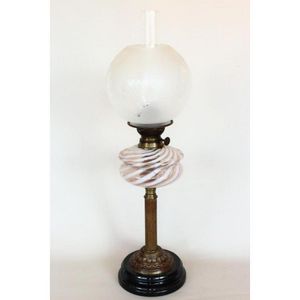Elkington Victorian Banquet Lamp with Classical Revival Motifs
You must be a subscriber, and be logged in to view price and dealer details.
Subscribe Now to view actual auction price for this item
When you subscribe, you have the option of setting the currency in which to display prices to $Au, $US, $NZ or Stg.
- Bas Relief - Bas relief, or low relief, is a carved surface in which the figures project from the background, but only to a limited extent. When a relief is cut in from a flat surface of stone or wood, the background or field is lowered, leaving the unsculpted parts seemingly raised. There are other degrees of relief carving, including high relief and mid relief.
- Anthemion - An anthemion is a classical decorative design element based on the acanthus flower that consists of a central circular or oval motif surrounded by radiating petals or leaves. It is often used as a border or frieze in architecture, furniture, and other decorative arts. The anthemion is derived from the palmette, a motif that was popular in ancient Greek and Roman art and architecture. It is often associated with the classical world and with Neoclassical style, and it is often used to add a sense of grandeur and formality to a design. The anthemion is also known as a honeysuckle or honeysuckle ornament. It continues to be used in a variety of contexts today, and it is often admired for its elegant and decorative qualities.
- Victorian Period - The Victorian period of furniture and decorative arts design covers the reign of Queen Victoria from 1837 to 1901. There was not one dominant style of furniture in the Victorian period. Designers used and modified many historical styles such as Gothic, Tudor, Elizabethan, English Rococo, Neoclassical and others, although use of some styles, such as English Rococo and Gothic tended to dominate the furniture manufacture of the period.
The Victorian period was preceded by the Regency and William IV periods, and followed by the Edwardian period, named for Edward VII (1841 ? 1910) who was King of the United Kingdom and the British Dominions and Emperor of India for the brief period from 1901 until his death in 1910.
This item has been included into following indexes:
Visually similar items

A Continental silver (800) three branch candelabrum, 672g, height 30 cm

Victorian oil lamp, with glass chimney, spherical shade above bowl supported on facetted column on circular base, height 75 cm

Antique silver plated oil lamp, 65 cm high

A silver plate candlestick, 19th century. Theribbed shaped column with an acanthus decorated base to a stepped spreading foot, and having an urn form nozzle. Height 28 cm
